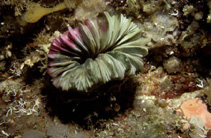Desmophyllum dianthus (Esper, 1794)
Cockscomb cup coral| Native range | All suitable habitat | Point map | Year 2050 |

|
| This map was computer-generated and has not yet been reviewed. |
| Desmophyllum dianthus AquaMaps Data sources: GBIF OBIS |
Classification / Names Populärnamn | synonymer | CoL | ITIS | WoRMS
Hexacorallia | Scleractinia | Caryophylliidae
Environment: milieu / climate zone / djupintervall / distribution range Ekologi
Revassocierade; djupintervall 8 - 2500 m (Ref. 87801), usually 200 - 2500 m (Ref. 120488). Subtropical; 8°C - 14°C (Ref. 87801); 83°N - 56°S, 180°W - 180°E
Distribution Länder | FAO områden | Ekosystem | Förekomster | Utplanteringar
Cosmopolitan. Tropical to polar.
Length at first maturity / Size / Weight / Age
Könsmognad: Lm ? range ? - ? cm
Life cycle and mating behavior Könsmognad | Reproduktion | Lek | Eggs | Fecundity | Larvae
Main reference
referenser | Koordinator | Medarbetare
Waller, R.G. and P.A. Tyler 2005 The reproductive biology of two deep-water, reef building scleractinians from the North East Atlantic Ocean. Springer-Verlag. Coral Reefs. 24:514-522. (Ref. 810)
IUCN Red List Status
(Ref. 130435: Version 2025-1)
CITES status (Ref. 108899)
CMS (Ref. 116361)
Threat to humans
Human uses
| FishSource |
Verktyg
Ytterligare information
Födosammansättning
Födointag
Predatorer
Max. ages / sizes
Length-weight rel.
Length-length rel.
Length-frequencies
Mass conversion
Abundans
Internet-källor
BHL | BOLD Systems | CISTI | DiscoverLife | FAO(Publication : search) | Fishipedia | GenBank (genome, nucleotide) | GloBI | Gomexsi | Google Books | Google Scholar | Google | PubMed | Tree of Life | Wikipedia (Go, sök) | Zoological Record



